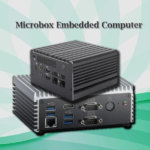What is a Fanless Embedded Computer?
The way industry utilizes computers has developed to include applications inside the computers, known as embedded PC. How exactly is embedded PC different from the everyday PC? Embedded computers offer control ability in a small box and ready to use in industrial environment with flexible operating systems.
An embedded computer, also known as an embedded PC, is a computer system that is implemented into a larger system or intelligence system commonly used for data collection or modern interactive tasks. Embedded computers come in various shapes and sizes fit for industrial or military applications. Moreover, embedded computers play an important role in the Internet of Things (IoT) and the connection between machines, people, and places.
What are Embedded Computers used for?
Embedded computers are used in many industries in the world. Most of the industries required high-performance computers that can integrate into the existing device easily. Embedded computers referred to as a self-contained PC that used as part of a larger system. Moreover, embedded computers serve as data collection or modern interactive tasks. Embedded computers are a technology that people and the smart system can rely on nowadays. There are several benefits of using an embedded computer in a larger device or system.
First, embedded computers offer a number of important advantages than a regular consumer PC. With the low maintenance feature, the embedded computer itself provides reliability inside complex systems. Industrial computers are provided with fanless enclosure design to reduce the heat while computers in operation. Furthermore, most of the environmental damages included dust, water, and vibration. Therefore, with stronger protection such as metal steel or IP rated housing, can reduce environmental damages.
On the other hand, fanless embedded computers brought a lot of benefits to industrial places. For example, the passive cooling system helps the embedded computer to remain sealed while reducing the heat. By removing the fan it decreases failure rates, reduces the noise, and provides spaces for integrated components.
Advantages of Embedded Computers
Embedded computers collect and process data from sensors to the IoT networks. Furthermore, embedded computers provided real-time reactions to support the device and system. Moreover, embedded computers also maintain security and safety. Most of the embedded computers support with wide working temperature for a situation where heat generated often.
Industry 4.0 Transforming Manufacturing
Industry 4.0 system gives flexibility and connectivity which makes it easier for users. Furthermore, flexible manufacturing allows the factory to produce more products using the same equipment. Moreover, industry 4.0 also brings convenient maintenance to the factory. Factories only need to replace the modularized faulty components for repair, without sending the entire product. Modularized IPCs allow specific applications and selecting areas from a single product to upgrade or downgrade as customers’ requirements.
Why Modularize the Platform?
Modularizing the platform of embedded computers helps to increase flexibility. The diversity in modular options allows users to choose specific configurations according to their application requirements.
With modularize platforms, it is easy to maintenance and upgrades certain parts of the whole unit. By doing modularize platform also reduce the cost of users because users only pay for the features they required. Therefore, the ability to detach and replace defective modules minimizes maintenance efforts and costs.





